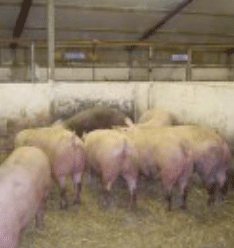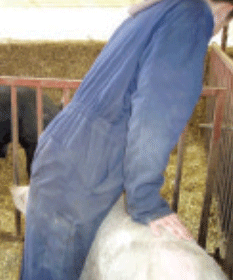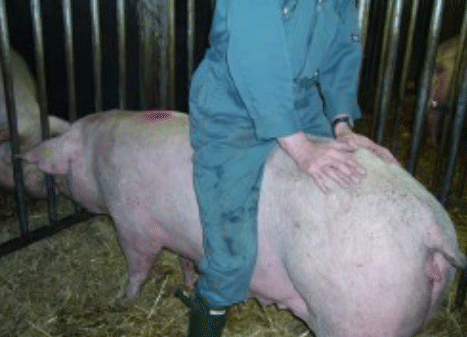



Effective Heat Detection
Advice of optimising heat detection in sows and gilt from BPEX in no. 29 in its 'Action for Prodictivity' series.Accurate heat detection is essential for the correct timing of insemination, however, heat (oesturs) is often missed or misdiagnosed because the signs are overlooked.
Follow the management guidelines below to ensure good timing, successful insemination and improved reproductive performance.
Management Guidelines
Take your time and know your pigs
- Not all signs of heat are exhibited in any one female and response to boar contact can vary
- Knowing your pigs will help you to recognise signs and take appropriate action to detect accurately the onset of oestrus
- Always approach your pigs calmly and avoid interrupting their normal behaviour
- Allow time to observe their true behaviour; allow reaction to your presence to subside
- Many females respond instantly to boar presence, others take a few minutes
- Some females may only exhibit a standing reflex for the boar they have had most contact with
- Be patient and don’t be afraid to develop a bond!
Look for signs of coming into heat twice daily if possible

- Proestrus is the first signal to watch for
- The proestrus period occurs just before oestrus and lasts about one day
- Identifying proestrus helps to predict the timing of standing heat and insemination
- Allow at least seven hours between checks
Check for some or all of these signs:
- Back end: swollen, red vulva (more notable in gilts than sows), watery discharge from vulva, clitoris flat and pale pink, becoming more prominent
- Activity: restless, climb up gates and walls, mount other females but do not stand themselves, increasing interest in the boar
- Sounds: high-pitched whining
Look for signs of being in standing heat
- The oestrus period can last one to three days with ovulation often occurring late on the second day of ‘standing heat’
- Standing heat is when the sow/gilt is receptive and will stand for mating/service
- Accurately identifying the start of first standing heat is essential for good timing and successful insemination
Check for some or all of these signs:
- Back end: vulva appears normal (swelling and redness subsides), sticky discharge from vulva, clitoris red and protruding, tail upright whilst standing and flicks up and down
- Activity: poor appetite, pricked ears, stand with arched back, glazed eyes, trembling, attracted to stockperson, seek boar contact (if allowed), stand rigid if mounted
- Sounds: very vocal with repeated grunts or long growls
Test for a standing reflex (the best indicator):
- Check twice daily if possible, at least seven hours between checks
- Apply pressure to the back and flanks
- Do this at the same time as renewed boar presence
- Receptive females will stand rigid and ears often prick up
Use the boar effectively and only when the stockperson is there to observe
- Pheromones (odours) produced by active and chatty boars are the most potent and effective means of inducing the standing reflex in females
- To maintain their libido allow regular services with cull sows
- Females in heat will usually move forwards and assume standing reflex as a boar moves in front of them
- The correct use of a vasectomised boar with breeding females can play an important part in stimulating and detecting heat, discuss with your vet
- Supervised entire boars can also be used for heat detection, but must not be left in with a group of sows awaiting AI
Use a heat detection pen:

- Take females to the boar
- Use a designated pen rather than one where pigs are housed normally
- Pen design should allow observation and physical contact (fenceline and direct)
Check small groups:
- Aim to check only two females at a time
- Apply the back pressure test at the same time as exposure to the boar
- Remove females found to be in heat to allow the boar to concentrate on checking/stimulating heat in others
Avoid habituation:
- Avoid exposing females to the boar for extended periods
- Rotate boars used for heat detection
For breeding sows:
- Provide 10-15 minutes per day of full boar contact for the first three days after weaning
- Fenceline contact with an entire or vasectomised boar should be sufficient
- It is essential to remove boar contact 24 hours before the start of oestrus detection to heighten sow resonse from day four
- Mark and record sows in heat to aid timing of insemination

Check for returns daily using a boar until confirmed in pig
Identifying females that come back into heat is important for highlighting problems and rescheduling inseminations. Pay particular attention to likely returns around the projected return date (18 to 24 days after service).
Following insemination:
- Watch for restless activity
- Note any females that mount or ride other females
- Provide and observe boar stimulation (10 to 15 minutes per day)
- Mark and record any likely returns
Keep records and use a marker system
- Being organised and efficient is essential for successful heat detection and insemination.
- Clear records and coloured marks make it easy to know what is happening with each female and what needs to be done next
Record responses: Note tag number, date and time of proestrus, date and time of oestrus and standing heat plus any comments.
Develop a coloured marker system: Use different coloured spray markers and/or the position, shape or number of marks to show clearly the status of each female.
May 2013








